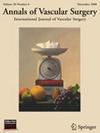开窗主动脉腔内修复术抢救腹主动脉瘤修复失败。
IF 1.6
4区 医学
Q3 PERIPHERAL VASCULAR DISEASE
引用次数: 0
摘要
目的:开窗血管内主动脉修复术(FEVAR)可用于腹主动脉瘤(AAA)修复失败的抢救。我们描述了我们使用市售的Zenith开窗(ZFEN)平台抢救失败的AAA维修的经验。方法:回顾性分析2012年1月至2019年8月在某三级学术医疗中心进行的所有FEVARs。该研究比较了初次FEVAR修复和再手术FEVAR (RFEVAR)修复先前的肾下动脉瘤修复,随访60个月。主要的结果是技术上的成功。次要结局包括死亡率、再干预和并发症。结果:153例患者符合纳入标准,其中一期修复133例,RFEVAR修复20例。修复指征包括近端疾病进展(55%)和IA型内漏(45%)。首次FEVAR修复与降低病例复杂性相关,手术时间较短(217.6分钟vs 265.6分钟,p=0.018),内脏动脉支架数量较短(2.2 vs 2.6, p=0.021)。初级FEVAR组的技术成功率为97.7%,而RFEVAR组为95.0% (p=0.43)。在60个月时,两组之间的估计生存率和再次干预自由度没有差异,在RFEVAR组分别为68.8% (p=0.38)和76.0% (p=0.80)。结论:使用ZFEN的RFEVAR对于挽救失败的AAA修复是有效的,60个月的结果与使用FEVAR的AAA初次修复相当。与传统的开放入路相比,RFEVAR具有吸引力,因为它避免了显著的发病率。这些结果支持ZFEN对挽救失败主动脉修复的长期疗效。本文章由计算机程序翻译,如有差异,请以英文原文为准。
Salvage of Failing Abdominal Aortic Aneurysm Repairs with Fenestrated Endovascular Aortic Repair
Background
Fenestrated endovascular aortic repair (FEVAR) can be used for salvage of failing abdominal aortic aneurysm (AAA) repairs. We describe our experience with the commercially available Zenith fenestrated (ZFEN) platform to salvage failing AAA repairs.
Methods
This is a retrospective review of all FEVARs performed from January 2012 until August 2019 at a tertiary academic medical center. The study compared primary FEVAR against reoperative FEVARs (RFEVAR) done for salvage of prior infrarenal aneurysm repairs with 60 months of follow-up. The primary outcome was technical success. Secondary outcomes included mortality, reintervention, and complications.
Results
There were 153 patients meeting inclusion criteria, with 133 primary repairs and 20 RFEVARs. Indications for repair included proximal disease progression (55%) and type IA endoleak (45%). Primary FEVARs were associated with decreased case complexity, with shorter operative time (217.6 vs. 265.6 minutes, P = 0.018) and number of visceral arteries stented (2.2 vs. 2.6, P = 0.021). Technical success was 97.7% in the primary FEVAR group, versus 95.0% in the RFEVAR group (P = 0.43). At 60 months, estimated survival and freedom from reintervention did not differ between groups and were 68.8% (P = 0.38) and 76.0% (P = 0.80), respectively, in the RFEVAR group.
Conclusion
RFEVAR using ZFEN is effective to salvage failing AAA repairs, with 60-month outcomes comparable to primary repair of AAA using FEVAR. RFEVAR is attractive over traditional open approaches as it avoids significant morbidity. These results support the long-term efficacy of ZFEN to salvage failing aortic repairs.
求助全文
通过发布文献求助,成功后即可免费获取论文全文。
去求助
来源期刊
CiteScore
3.00
自引率
13.30%
发文量
603
审稿时长
50 days
期刊介绍:
Annals of Vascular Surgery, published eight times a year, invites original manuscripts reporting clinical and experimental work in vascular surgery for peer review. Articles may be submitted for the following sections of the journal:
Clinical Research (reports of clinical series, new drug or medical device trials)
Basic Science Research (new investigations, experimental work)
Case Reports (reports on a limited series of patients)
General Reviews (scholarly review of the existing literature on a relevant topic)
Developments in Endovascular and Endoscopic Surgery
Selected Techniques (technical maneuvers)
Historical Notes (interesting vignettes from the early days of vascular surgery)
Editorials/Correspondence

 求助内容:
求助内容: 应助结果提醒方式:
应助结果提醒方式:


